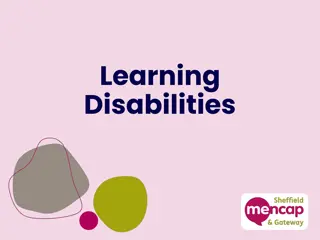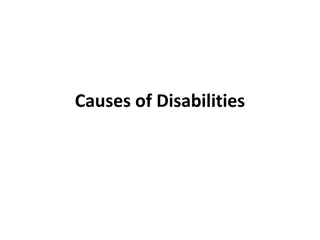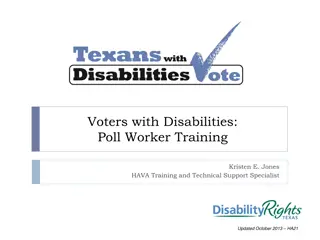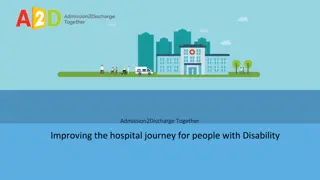Understanding Communication Challenges in Adults with Learning Disabilities
Explore the complexities of communication difficulties faced by adults with learning disabilities, affecting up to 90% of this population. Understand the individualized communication needs based on varying factors like co-occurring diagnoses and existing support systems. Delve into the risks posed by ineffective communication, such as impacting overall health and mental well-being. Discover the factors influencing communication and the specific challenges individuals may encounter, from vocabulary limitations to speech difficulties. Gain insight into how communication happens and the importance of addressing these challenges within the CALDS community.
Download Presentation

Please find below an Image/Link to download the presentation.
The content on the website is provided AS IS for your information and personal use only. It may not be sold, licensed, or shared on other websites without obtaining consent from the author. Download presentation by click this link. If you encounter any issues during the download, it is possible that the publisher has removed the file from their server.
E N D
Presentation Transcript
Do you understand me? - Let s Talk about Communication Speech and Language Therapy Community Adult Learning Disability Service (CALDS)
Learning Disability and Communication Needs Within the population of people with a learning disability, it is estimated 50-90% have difficulties with communication (RCSLT, 2019). Each person s communication needs are individual depending on: Their level of learning disability Whether they have any co-occurring diagnoses (e.g. sensory impairment, Autism, physical disability, acquired conditions such as a stroke, etc) Whether they have tools in place to meet their communication needs
How does Communication Happen? Communication requires a person to send a message and another person to receive the message. During this session we will cover both how people may express themselves (communication) and how people understand information given to them (understanding).
Difficulty Communicating What are the Risks for the Person? There are major implications for a person s overall health if they are unable to express their needs effectively. Common issues include: Expressing the level, severity and intensity of pain Describing symptoms accurately Explaining the frequency and location of symptoms Frustration at not being able to express themselves clearly, which can sometimes lead to changes in behaviour e.g. hitting out, self injury, shouting, withdrawal and wider impact on mental health. A person may not comply with medical procedures or with taking medication if they do not understand the reasons for this.
Factors that may affect a persons communication Poor physical health, pain or medication effects Mental health - fear, anxiety, feeling uncomfortable Poorly supported sensory impairment Distracting environment e.g. too much noise, being interrupted Busy environment, e.g. not enough time to process information, lots of information given in a short space of time Previous experience of being misunderstood or ignored Lack of access to resources/tools that would help e.g. communication device not charged, communication chart not within reach.
Communication Difficulties may Involve: Limited vocabulary- may not know a word or may use one word for multiple meanings. Limited use of grammar, which can cause ambiguity: Using the correct tense e.g. It was hurting vs it is hurting Using pronouns especially confusion of gender e.g. he for she, him for her . Word changes for plurals e.g. fall vs falls , pain vs pains Use of the and a/an and this/that e.g. the man means a specific man, a man does not. Limited amount of information in a sentence and difficulty joining sentences. Difficulties using various language functions e.g. can name but not describe. Speech difficulties that may impact on intelligibility. Physical disability may cause difficulties using some non verbal communication e.g. gestures.
How to Support Communication Needs: Read documentation about the person e.g. hospital traffic light. Ask the person/ carers about how to best support their communication. Accept and encourage all communication e.g. speech, sign, gesture, drawing, demonstration / action replay. Ensure pens and paper are available. Use photos and pictures to support the person to communicate. Communication boards, visual pain scales, body maps. If the person has an electronic communication device encourage them to use it. Some people may need to use actual objects to help explain something clearly e.g. through demonstrating. Watch the person and observe what they may tell you through their body language and facial expression. Check with the person that you understand what they are saying e.g. "the TVs not working? Is that right?"
Communication tools Examples of communication boards An example of a visual pain scale
Signing Some people need signs to help them understand, some people need signs to help them express themselves Signing is visual - easier to process and remember. It is less fleeting than a spoken word. It uses different muscles to spoken words. There are different types of signing: BSL (British Sign Language) is a true language. It has its own grammar that is very different to English. Sign Supported English is where people use signs alongside speaking English. The signs might be taken from British Sign Language but used in English word order. Or they might be from Makaton or Signalong. Some people may use the fingerspelling alphabet. Some people may make up their own version of signs or adapt them slightly- check with people that know them well to clarify what a sign means.
Difficulties with Understanding may Involve: Limited understanding of vocabulary. Difficulty understanding negatives in a sentence e.g. That isn t yours . These sentences are often understood as positive statements i.e. That s yours . Difficulty understanding more than one piece of verbal information at a time. Difficulties understanding some questions e.g. when , how , why . Difficulty understanding phrases of time e.g., weekly, next month, frequently An inability to understand that the words might , may , could express a possibility not a certainty. Difficulty understanding idioms, jokes, teasing, sarcasm and irony. Difficulty recognising that they ve misunderstood another person s communication or agreeing to what someone says because of lack of understanding or to appease the person. Limited understanding of other people's communication e.g. lack of understanding of objects, routines, facial expressions, tone of voice.
How to Support Understanding: Read documentation about the person and speak to carers and family members. Find somewhere without distraction. Reduce background noise. Use accessible language- every day common words and avoid jargon and acronyms. Avoid using complex sentences, keep it short and simple. Allow plenty of time for them to process the information and repeat information when needed. Ask open questions and if the person finds this hard to answer, try asking simple what? and yes/ no questions or offer choices. Look out for signs the person doesn t understand. Check back to ensure they understand. Try drawing and writing key points to help explain what you mean. Use pictures to help the person understand the key points being said. Make sure to follow the Accessible Information Standards (NHS England). Use real objects, demonstration and video recordings to help a person understand. Make sure your facial expression matches your tone of voice and the words you use. If you're asking if someone is happy or unhappy, make your facial expression correspond to reinforce what you're saying.
Thank you for your time! Please contact the SLTs in the Community Adult Learning Disability Service if you require any further support or advice.























